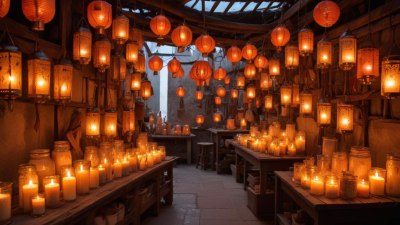Learning to Make Local Candles and Lanterns in Workshops
Discover local workshops for candle and lantern making. Create unique crafts with sustainable materials!

This image was created with the assistance of Freepik
Candles and lanterns have long been celebrated as symbols of warmth and light, often evoking feelings of nostalgia and comfort. In many cultures, the act of creating these beautiful items has transcended mere utility to become a cherished art form. Learning to make candles and lanterns in workshops offers participants a unique opportunity to connect with their creativity while gaining valuable skills in craftsmanship.
This article explores the intricacies of local workshops dedicated to candle and lantern making. We’ll look at different crafting techniques, the materials used, and how these workshops serve the community. Additionally, we’ll delve into the historical significance of these crafts, the environmental benefits of making your own lighting, and tips for choosing the right workshop for your needs.
The Art of Candle Making
Candle making is an ancient craft that dates back thousands of years. Originally, candles were crafted from animal fat or beeswax, serving practical purposes before evolving into decorative and scented items. Today, a variety of materials are available, including paraffin wax, soy wax, and palm wax, each offering distinct benefits and environmental considerations.
Local workshops typically provide hands-on opportunities to learn about different types of wax, the science behind candle-making (such as melting temperatures and fragrance incorporation), and safety precautions. Participants often start with foundational techniques such as pouring, molding, and wick placement before moving on to more complex methods like layering colors or embedding objects within the candle.
One of the most alluring aspects of candle making workshops is the ability to craft to your personal aesthetic. Participants can choose from an array of fragrances, colors, and shapes, allowing each finished product to reflect their individuality. Additionally, many workshops prioritize the use of eco-friendly materials, encouraging participants to adopt sustainable practices in their crafting.
The Charm of Lantern Making
Lanterns, similar to candles, have deep historical roots, used around the world for light, decoration, and festive occasions. From simple designs to elaborate structures, lanterns can be made from a variety of materials, including paper, metal, and glass. The process of making a lantern varies significantly based on the chosen materials and the intended final appearance.
Workshops often guide participants through the entire lantern-making process, including selecting the base structure, decorating with paints or cutouts, and integrating lights. The joyous experience is further enhanced when groups get to work collaboratively, sharing ideas and techniques to create unique, communal pieces. Events such as lantern festivals highlight the playful spirit of lantern making, where participants craft lanterns that can be displayed in a collective setting.
The Benefits of Attending Workshops
Attending a workshop doesn’t solely focus on the crafts themselves; it fosters community engagement and connection. Many local workshops bring together individuals with a shared interest, creating a vibrant atmosphere of collaboration and learning. They often provide materials and tools, making the experience accessible for beginners who benefit from guided instruction.
Moreover, workshops can cater to various skill levels, from novices looking to explore new hobbies to experienced individuals seeking to refine their techniques. The smaller class sizes often found in local workshops allow for personalized guidance, ensuring that participants gain confidence as they navigate the crafting process. Feedback and encouragement from instructors and peers alike can significantly enhance the overall experience.
Environmental Considerations
In an age of increased consciousness regarding environmental impact, many workshops place emphasis on sustainability. Participants are often educated about the implications of different materials, such as the benefits of using soy wax over traditional paraffin wax, which can release harmful pollutants. Moreover, workshops may also highlight the importance of recycling and reusing materials, encouraging tourists to bring in old containers or glass jars to use as candle holders or lantern bodies.
Creating your own candles and lanterns also allows for reduced waste in packaging since many workshops encourage participants to bring their own containers or sustainable packaging materials. This focus on minimalism and ecological responsibility fosters deeper connections between participants and their crafts, emphasizing a long-lasting appreciation for the materials used.
Finding the Right Workshop
For those intrigued by the idea of creating their own candles and lanterns, finding the right workshop is the first step on this exciting journey. Numerous factors should be considered when exploring options:
- Location: Check for local offerings to minimize travel and support nearby artisans.
- Reputation: Look for reviews and testimonials about the facilitators and previous workshops offered.
- Materials Used: Investigate the types of materials provided; prioritize those that align with your values regarding sustainability.
- Class Size: Smaller groups generally allow for more personalized attention and effective learning experiences.
- Duration and Cost: Assess whether the time commitment and price align with your budget and schedule.
The Community Aspect
Attending local workshops for candle and lantern making is not just about the product; it’s about the community and connections one forms. Engaging with others who share similar interests creates a sense of belonging and enrichment that goes beyond the crafting itself. For many, candle and lantern making workshops are a gateway to new friendships, collaboration, and even business ventures.
Furthermore, community-centric workshops often emphasize sharing skills with future generations. Many instructors are passionate about passing down traditional crafting techniques and stories, ensuring that the art of candle and lantern making continues to thrive. Participants often leave with not only their crafted items but also a renewed appreciation for this historic art form.
Creating Meaningful Gifts
Handmade candles and lanterns make for heartfelt gifts that convey thoughtfulness and effort. When crafting your own, you can personalize each creation to reflect the recipient's tastes and preferences. Workshops often encourage participants to consider the significance behind the items they create, making the crafting experience even more enriching.
For various celebrations, such as birthdays, weddings, and holidays, handmade candles and lanterns infused with personal meaning stand out far more than mass-produced gifts. This intention behind the crafting further promotes the emotional connection between the giver and receiver, underscoring the value of handmade items in our increasingly commercial world.
The Process of Enjoying Your Creations
Once the candles and lanterns are completed, the joy continues with the process of using and displaying them. Candles can elevate ordinary spaces, providing warmth and ambiance, while lanterns enhance outdoor areas, creating magical atmospheres during gatherings. Furthermore, both serve practical purposes, like lighting up a path during a night event or creating a cozy setting in your living room.
Many participants take pride in finishing their projects, often showcasing their creations in their homes or gifting them to friends and family. By sharing their craft experiences and improvements, they contribute to the larger community of creators, encouraging others to explore their creative potential.
Learning to make local candles and lanterns in workshops is not merely about crafting; it’s about discovering connections—connections with materials, the community, and oneself. These workshops provide enriched experiences that forge bonds while allowing individuals to express their creativity sustainably. Moreover, the skills learned empower individuals to share their artistry with loved ones, creating a beautiful cycle of generosity and appreciation.
Whether you are a seasoned crafter or just beginning, participating in these workshops opens doorways to a myriad of possibilities. By embracing the beauty of handmade items, you contribute to the preservation of traditional arts, foster connections, and discover the joy of creating something truly unique.











